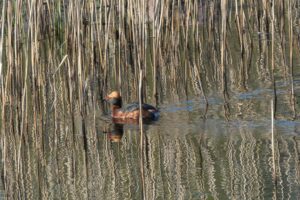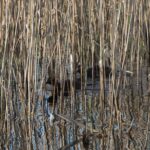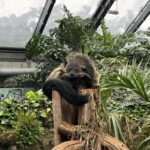 Each year, on the second Saturday in May, both World Binturong and World Migratory Bird Day are celebrated around the world. The celebration of World Binturong Day will take place as usual on Saturday, despite the unexpected sad death of our two-month-old binturong cub on Thursday night. At least one of the adult binturongs will be present in the rainforest exhibition for visitors to view. To allay the concerns of a mother looking for her cub, an attempt is being made to reunite the pair.
Each year, on the second Saturday in May, both World Binturong and World Migratory Bird Day are celebrated around the world. The celebration of World Binturong Day will take place as usual on Saturday, despite the unexpected sad death of our two-month-old binturong cub on Thursday night. At least one of the adult binturongs will be present in the rainforest exhibition for visitors to view. To allay the concerns of a mother looking for her cub, an attempt is being made to reunite the pair.
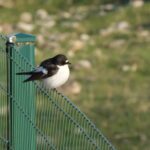 This year, World Migratory Bird Day will be focusing on the importance of insects. If there is nothing to eat, there is no energy to travel. The European pied flycatcher, which usually arrives in early May, is sitting on the fence with its feathers ruffled due to the cool weather. In the current cold and insect-free spring in Estonia, it will be difficult for her to compete with the great tit for a nesting place.
This year, World Migratory Bird Day will be focusing on the importance of insects. If there is nothing to eat, there is no energy to travel. The European pied flycatcher, which usually arrives in early May, is sitting on the fence with its feathers ruffled due to the cool weather. In the current cold and insect-free spring in Estonia, it will be difficult for her to compete with the great tit for a nesting place.
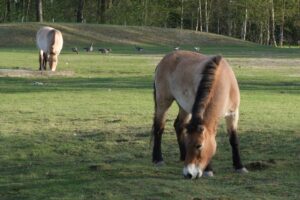
 However, greater white-fronted geese feel at home in the zoo, and can be found in almost every major meadow and field here. They feed in the meadows by bird ponds, in the enclosures of Przewalski horses and Père David’s deer, as well as on other lawns and flower fields. In addition to the fact that free-ranging geese fearlessly moving about the zoo also enrich our exposition, they also seem to have practical benefits in every way – the colony of black-headed gulls has left the zoo’s bird ponds.
However, greater white-fronted geese feel at home in the zoo, and can be found in almost every major meadow and field here. They feed in the meadows by bird ponds, in the enclosures of Przewalski horses and Père David’s deer, as well as on other lawns and flower fields. In addition to the fact that free-ranging geese fearlessly moving about the zoo also enrich our exposition, they also seem to have practical benefits in every way – the colony of black-headed gulls has left the zoo’s bird ponds.
 The horned grebe, a category II protected species in Estonia, has once again arrived to nest this year at the bird bonds. You can also find a common moorhen, with its red and yellow beak, in the vegetation rich area along the edge of the pond, and a slightly larger Eurasian coot, with a white bill and white frontal shield, has also been seen. The mute swan pair has been exploring nesting opportunities on the pond’s island, while a pair of familiar common terns have made themselves at home on the pelican statue.
The horned grebe, a category II protected species in Estonia, has once again arrived to nest this year at the bird bonds. You can also find a common moorhen, with its red and yellow beak, in the vegetation rich area along the edge of the pond, and a slightly larger Eurasian coot, with a white bill and white frontal shield, has also been seen. The mute swan pair has been exploring nesting opportunities on the pond’s island, while a pair of familiar common terns have made themselves at home on the pelican statue.
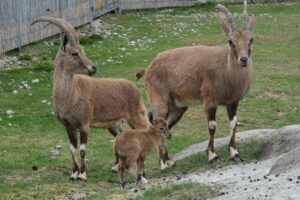 On Sunday, Mother’s Day will be celebrated around the world. Gradually, new mothers are also appearing at the zoo. On Thursday morning, the first Nubian ibex kids were born. Of the two kids born, one was weak and needed human support, the other, on the other hand, is gallantly prancing around with the herd.
On Sunday, Mother’s Day will be celebrated around the world. Gradually, new mothers are also appearing at the zoo. On Thursday morning, the first Nubian ibex kids were born. Of the two kids born, one was weak and needed human support, the other, on the other hand, is gallantly prancing around with the herd.

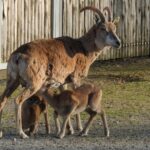 In the Transcaspian Urial enclosure you can see the gang of kids boldly prancing about. They only seek out their own mother when they get hungry.
In the Transcaspian Urial enclosure you can see the gang of kids boldly prancing about. They only seek out their own mother when they get hungry.
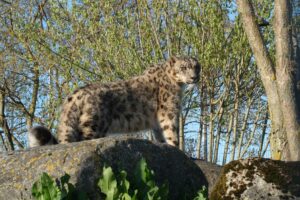
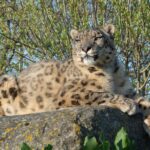 The snow leopard, the top predator in the Alpinarium, will have an exciting time keeping its eyes on the surrounding enclosures, during spring anyway.
The snow leopard, the top predator in the Alpinarium, will have an exciting time keeping its eyes on the surrounding enclosures, during spring anyway.
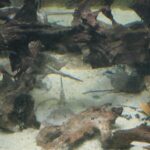 The last eight of the river stingray’s pups were moved to a large aquarium reaching the ground, joining the previously born river stingray pups. In total, there should now be 19 of them, although it is quite difficult to count river stingrays who love to hide under the sand.
The last eight of the river stingray’s pups were moved to a large aquarium reaching the ground, joining the previously born river stingray pups. In total, there should now be 19 of them, although it is quite difficult to count river stingrays who love to hide under the sand.
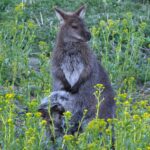 Some of the Bennett’s tree-kangaroo joeys are already quite large and can barely fit in their mothers’ pouches, but they still take the opportunity to spend a cool afternoon in the warmth of the pouch, so what if their long hind legs are left hanging out.
Some of the Bennett’s tree-kangaroo joeys are already quite large and can barely fit in their mothers’ pouches, but they still take the opportunity to spend a cool afternoon in the warmth of the pouch, so what if their long hind legs are left hanging out.
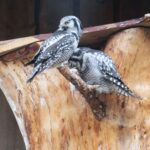
 On Hawk Hill, a pair of northern hawk-owls can be seen fiddling with a mouse at a large nest box. 19. Since 19 April, three striped northern hawk-owl have hatched one after another inside of the nest box, with the mother now feeding them with different sized food depending on their age.
On Hawk Hill, a pair of northern hawk-owls can be seen fiddling with a mouse at a large nest box. 19. Since 19 April, three striped northern hawk-owl have hatched one after another inside of the nest box, with the mother now feeding them with different sized food depending on their age.
 Last Saturday, all of the native Kihnu sheep at the children’s zoo were freed from their winter wool.
Last Saturday, all of the native Kihnu sheep at the children’s zoo were freed from their winter wool.



